Folkestone, Sandgate and Hythe Tramways
History
The Folkestone, Sandgate and Hythe Tramways Company was incorporated by the Folkestone, Sandgate and Hythe Tramways Act of 1884, which received its Royal Assent on the 28th July that year. This authorised the company to build a tramway between Hythe in the west and Sandgate in the east, a distance of circa 2.3 miles; it also included a small branch from Sandgate Esplanade up to the South Eastern Railway Company's Sandgate Station, which was actually some distance to the west of central Sandgate. Although ostensibly independent, the FS&HTCo had very close connections to the SERCo, the 1884 Act permitting the latter to enter into various working arrangements with the former.
Matters seem to have rested there for a couple of years, probably because the act only authorised the use of horse traction, and it did not include a line into central Sandgate and beyond to Folkestone, which was the tramway's ultimate destination. To reach Folkestone would however, require the use of mechanical traction, as Sandgate Hill was too steep for horse-drawn working.
During this period, the SERCo built a temporary railway southwards from its station in Hythe, across private land, down to the coast and along it, in order to bring stone for major repair works to the sea wall. Although the line was clearly a railway, which had been built on railway principles, and was operated by steam traction, plans were soon hatched to incorporate it into an expanded passenger tramway.
As a result, new powers were obtained on the 25th June 1886 — under the Folkestone, Sandgate and Hythe Tramways Act, 1886 — which permitted the company to abandon a portion of the originally authorised line (at its western end), and to extend the time allowed for construction of the remainder. A new extension eastwards into Sandgate proper was also included, as well as permission to convert the temporary railway branch to a passenger tramway. Importantly, the act also authorised the SERCo to subscribe and contribute to the capital of the FS&HTCo.
Whilst the 1886 Act now authorised the use of mechanical power, Sandgate Local Board of Health (the local authority at the eastern end of the line) had successfully objected to the use of steam traction, its use on the section within Sandgate being expressly forbidden. Furthermore, the Earl of Radnor — a major land and property owner — had succeeded in having his own clause inserted into the legislation, which effectively gave him and his heirs a veto over the building of the portion of the tramway within Sandgate. In practice, this would mean that the company would have to meet the Earl's every wish if it were to reach the centre of Sandgate, let alone Folkestone.
There now followed another delay, possibly due to the need to complete the sea-wall repairs, before tenders for the passenger tramway were let in early 1888; as a result, the company was forced to seek an extension to the time allowed for the construction of the unbuilt lines. An extension to the time was duly authorised under the Folkestone, Sandgate and Hythe Tramways Act 1888, which received its Royal Assent on the 28th June that year. By this time, construction of the new lines was presumably well in hand, tenders having been issued in spring 1888.
Although work proceeded towards Sandgate, construction was stopped near Sandgate by the Earl of Radnor, who exercised his right of veto. Despite this setback, the rest of the work was completed, and a Board of Trade inspection was requested; unfortunately for the company, the inspector refused to grant permission for the tramway to open until certain works had been put in hand, so yet another delay ensued.
There matters rested for a while, the company instead seeking powers to extend the tramway at its less-contentious western end, to the Red Lion in Hythe. Powers to construct the extension were granted on the 26th July 1889 under the Folkestone, Sandgate and Hythe Tramways Act, 1889.
Meanwhile, the SERCo, in the form of Sir Edward Watkin, the chairman, entered into a fraught exchange of views with the Earl of Radnor and his representatives, the latter insisting that the tramway within Sandgate be built to a gauge of 3ft 6ins, despite the rest of the system having already been built to standard gauge (4ft 8½ins). Although this was dressed up as patrician concern for the elegance of Sandgate and Folkestone, and the people living there, other less high-minded motives would certainly have been in play. Following a visit to Sandgate by Watkin in early 1890, the SERCo thought that it had reached agreement to construct the line to standard gauge, only for Radnor to serve an injunction on the company on the 13th June, stopping the work. The injunction not only prevented work continuing, but legally bound the company to reduce the gauge by the 30th November 1890, a farcical situation that eventually led to Watkin giving a personal undertaking to Radnor that the line would not be used, in exchange for not having to go to the expense and ridicule of having to lift one of the rails.
After yet another hiatus, passenger services finally commenced, using two horse trams, on the 18th May 1891, but only between the Seabrook Hotel on Princes Parade in the west, and the outskirts of Sandgate in the east. This was followed just over a year later — on the 1st June 1892 — by the extension eastwards to the Red Lion in Hythe. Despite Watkin having purportedly resigned himself to having to convert the Sandgate tramway to 3ft 6ins gauge, and even having issued orders for this to be done, as well for a 3ft 6ins-gauge tramcar to be constructed, a letter now arrived at SERCo HQ from Radnor — out of the blue — suddenly agreeing to the construction of a standard-gauge line in the town. The motives for this volte-face remain unclear. Although no time was lost in signing an agreement, Radnor included yet another clause that was destine to cause the company problems, requiring them to support his position on any future plans. Construction of the line was quickly finished, the full through service into Sandgate commencing just weeks later on the 1st August 1892.
This brought the FS&HT to its final size of 3.36 miles. From a terminus outside the Red Lion Inn in Hythe, the line ran southwards to just short of the coast — via Rampart Road and Stade Street — before heading eastwards via South Road to join Princes Parade, which was owned by the company. At the end of Princes Parade, a branch led up to Sandgate Station, the main line continuing eastwards along Sandgate Esplanade to a terminus outside the Royal Oak pub in Sandgate High Street. The old railway line northwards to Hythe Station was never used by passenger trams as it was too steep for animal traction.
The line proved to be very successful, with high summer loadings, two more tramcars arriving in late summer 1892 to meet the demand, and a final one in 1897, taking the fleet to five tramcars. The first year's dividend was a very respectable 6%, though it was probably the last to be reported, as the SERCo proceeded to formally take over the FS&HTCo, a company that had, to all intents and purposes, been independent in name only. Powers to this end were acquired on the 29th June 1893 — under the South Eastern Railway Act, 1893 — the old company thereafter being dissolved.
On the 1st August 1899, the name of the tramway's owners was changed to the South Eastern and Chatham Railway Company, the SERCo having merged with its great rival — the London, Chatham and Dover Railway Company — under the South Eastern and London, Chatham and Dover Railway Companies Act, 1899.
The tramway continued its unhurried existence, doing excellent business in summer, but running a reduced service in winter. A couple of schemes for electric tramways were promoted in the late 1890s and early 1900s, and though they did not have the full support of the SE&CRCo, more ominously, they ran into serious opposition from the Earl of Radnor, who owned almost all of the western end of Folkestone, and who simply did not want the trams in his town.
Sandgate Urban District Council, as the successors to Sandgate Local Board of Health were entitled — under the Tramways Act of 1870 — to compulsorily purchase the horse tramway, or rather, those sections of it that had been enabled by the legislation of 1884, and which were within the district. This meant that Sandgate UDC could, if it so chose, compulsorily purchase the section of tramway between Sandgate Station and the coastguard station in 1905. Perhaps to the surprise of the company, the UDC was keen to exercise its rights, having lined up the National Electric Construction Company to carry out the conversion to electric traction, and operate the system too. The council did not, however, have any powers to purchase the remainder of the tramway, so had to negotiate with the SE&CRCo to purchase the entire undertaking. The SE&CRCo was probably glad to be shot of the tramway, so agreement was soon reached for the company to sell the tramway to council, who in 12 months' time would hand it over to the NECCo to electrify and operate it.
The 1892 agreement with Radnor now came back to haunt the SE&CRCo, as the Earl of Radnor, or rather his son, who had inherited the title on the death of his father, now wrote to the Board of Trade to object to the sale, unless of course, it preserved his veto. The SE&CRCo now not only faced opposition to the scheme from Radnor, but was itself placed in the embarrassing position of having to oppose it too, due to the agreement it had signed in 1892. To complicate matters even further, Folkestone had also acquired powers to build an electric tramway, so there were two competing schemes, both of which could not use overhead current collection due to the objections of Radnor. The NECCo eventually agreed to install a surface contact system (Dolter) to avoid the unsightly overhead wiring that Radnor objected to, and even paid a deposit of £2,000 to the SE&CRCo for the tramway. However, once the NECCo had hands-on experience of operating the troublesome Dolter system — on its Mexborough and Swinton system — it had second thoughts and pulled out, losing its deposit in the process.
The SE&CRCo was then left to operate an increasingly anachronistic horse tramway in the face of increasing motorbus competition, a thought that it could hardly have relished. It is therefore, perhaps no surprise that services were suspended on the 7th August 1914 for the duration of the Great War, no doubt to the relief of the company. The system re-opened in May 1919 using mules rather than horses, which were in short supply, as well as conductresses, men clearly being in short supply too. A sign of things to come was the absence of winter services, which given the war, had not run since 1913/14. With the track deteriorating badly, the summer of 1921 was to be the tramway's last, services ceasing for the final time on the 30th September 1921.
Uniforms
Although early photographs of the tramway have yet to come to light, written sources suggest that staff simply wore informal attire, uniforms only being issued following the take-over by the SERCo in 1893. Drivers were issued with three-quarter length, double-breasted, frock-style coats with four pairs of buttons, and lapels. The jacket was edged in a finer material than the main body; the collars bore embroidered insignia, probably the owning company's initials (either 'SER' or 'SE&CR'). Conductors on the other hand were issued with long single-breasted coats with eight buttons and stand-up collars; surviving photographs suggest that the coat collars did not bear insignia. The tensioned-crown peaked caps of both drivers and conductors may have borne a grade badge, but certainly not a metal one, as these would have shown up clearly on the surviving photographs.
The tramway closed during the Great War, and upon re-opening, the SE&CRCo appears to have taken a rather relaxed approach to uniforms. Although some photographs show staff wearing the pre-war uniforms, many show drivers and conductors wearing informal attire, including the large-crown flat caps of the period. However, as the high summer loadings probably led to the appointment of temporary staff, it may well be that these men were not issued with uniforms, both before and after the Great War.
Unusually, and perhaps uniquely, women were employed as conductresses after the Great War and up until closure, the reverse of the situation elsewhere, where they were employed during the Great War then released soon afterwards. These ladies were provided with piped, single-breasted jackets with lapels, and long matching skirts. Headgear took the form of a wide-brimmed bonnet turned up at one side in the manner of an Australian slouch hat. It is currently unclear whether these garments bore badges of any kind.
The only senior staff member was a foreman-cum-manager. In the 1920s, this individual wore a long, piped, double-breasted topcoat with lapels; the garment was edged in a finer material than the main body, and the collars bore embroidered insignia, possibly the bearer's grade. The tensioned-crown peaked cap bore a large round cap badge, probably an SECRCo issue of embroidered cloth.
Further reading
For a history of the system, see: 'The Hythe and Sandgate Railway, Incorporating the Hythe and Sandgate Tramway' by Brian Hart; Wild Swan Publications (1987).
Images
Horse tram drivers and conductors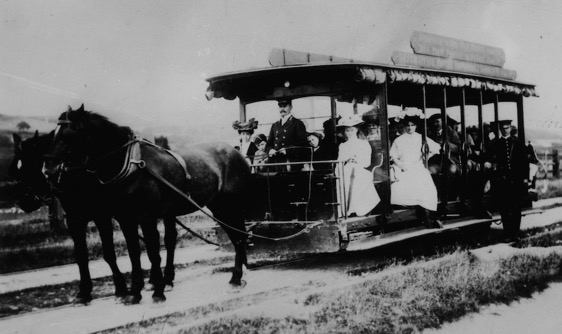
An unidentified covered toastrack car (either No 1, No 2 or No 4) waits in the passing loop on Princes Parade — photo undated, but probably taken in the early-Edwardian era given that the roof board carries 'SE&CR' lettering. With thanks to the National Tramway Museum. 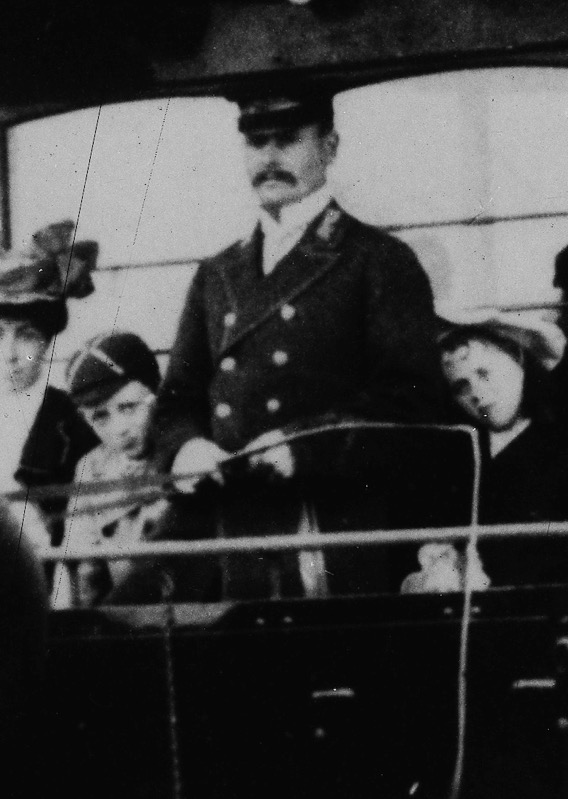
An enlargement of the above photograph showing the driver, who is wearing a smart, double-breasted jacket edged in a finer material than the main body, and with lapels; the collars clearly carry insignia of some description, almost certainly embroidered, and very probably the owning company's initials, i.e. 'SE&CR'. His tensioned-crown peaked cap possibly bears an embroidered badge, though this is far from certain.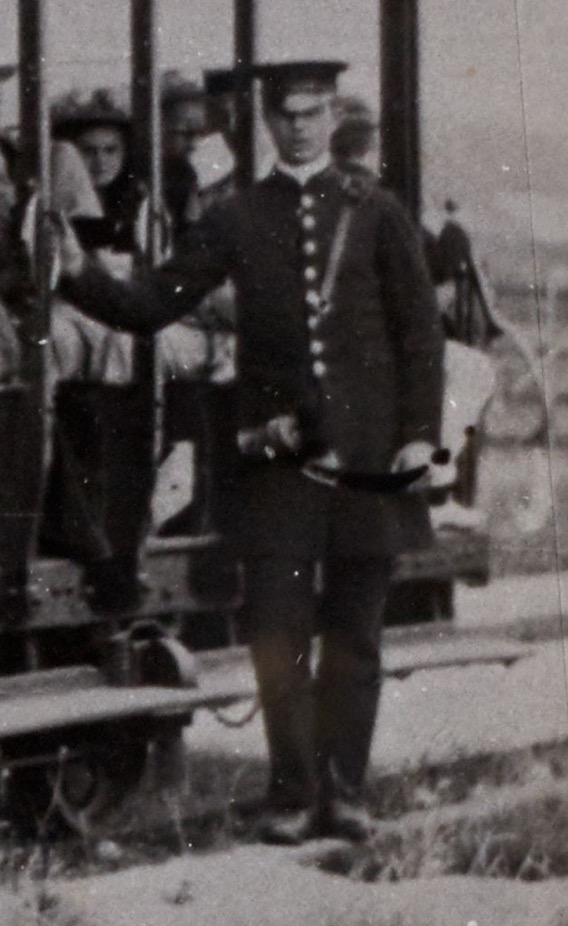
Another enlargement of the above photograph, this time of the conductor, who is wearing a long single-breasted coat with eight buttons and stand-up collars; the jacket collars do not appear to bear any insignia.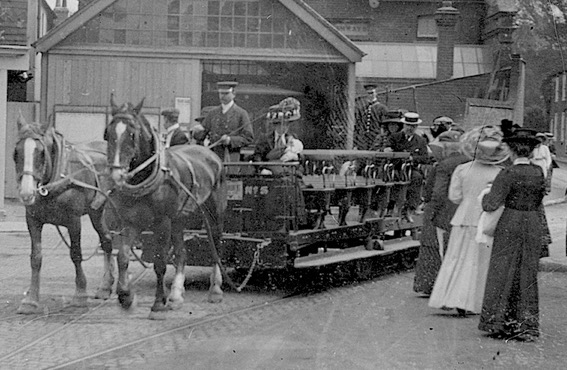
Toastrack Tram No 5 standing outside the depot at Hythe with a queue of passengers — photo undated, but from the fashions on display, probably early Edwardian. With thanks to the National Tramway Museum. 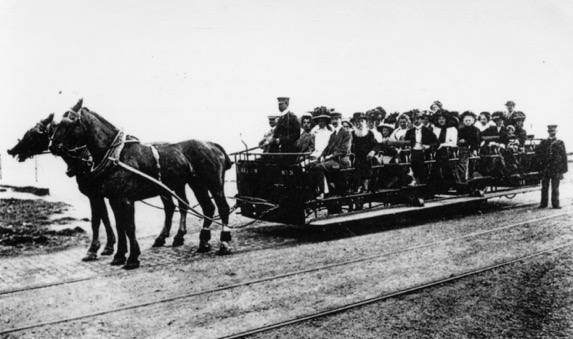
A fully laden No 5 in Princes Parade — photo purportedly taken in 1910. The driver and the conductor are wearing the same style of uniform seen in previous photographs. Photo courtesy of the Tramways and Light Railway Society, with thanks to David Voice.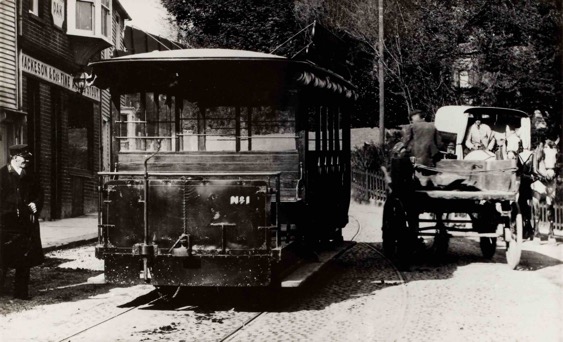
The driver of covered, cross-bench car No 1 holds his horses (out of shot to the left) after leading them around from the far side of the vehicle. The scene was captured at the extreme eastern end of the system outside the Royal Oak at the foot of Sandgate Hill. It is unclear when the photograph was taken, but possibly around 1910. Photo courtesy of the Tramways and Light Railway Society, with thanks to David Voice.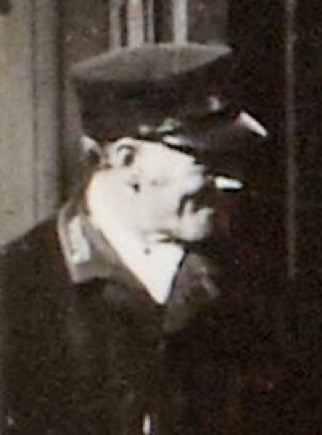
An enlargement of the above photograph showing the driver. His greatcoat collars clearly bear insignia of some description.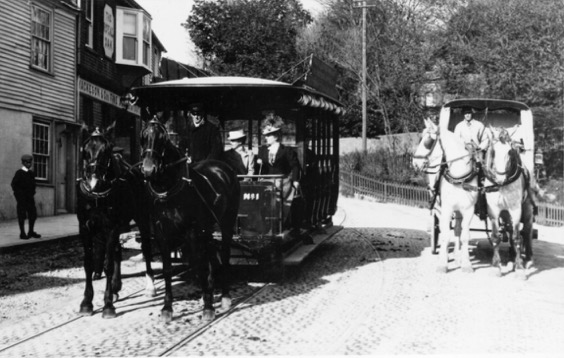
A photograph that was clearly taken at the same time, but shortly after the previous image. Photo courtesy of the Tramways and Light Railway Society, with thanks to David Voice.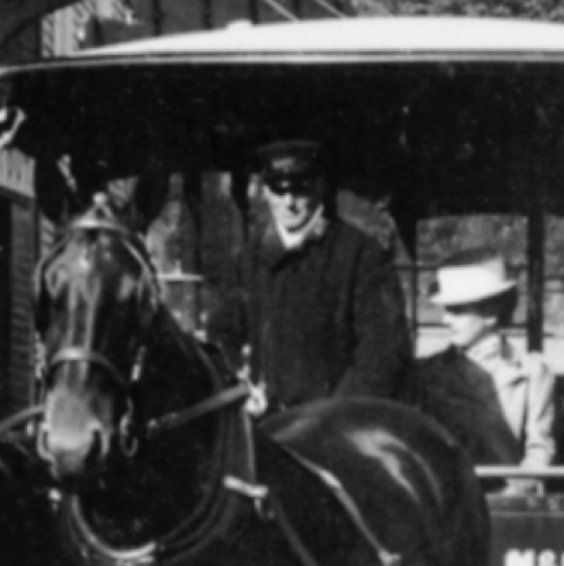
An enlargement of the above photograph showing the driver, who may possibly have a grade badge on his cap, though this is far from certain.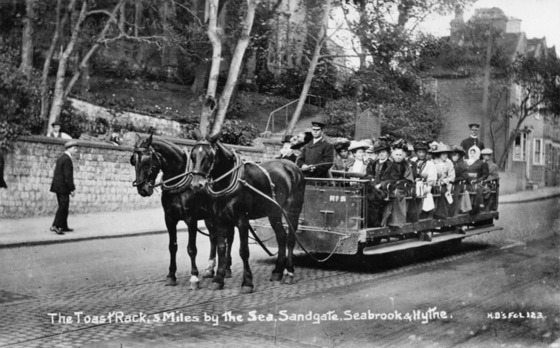
Horsecar No 5 pictured outside the steps to St Pauls Church in Sandgate High Street in 1912. Photo courtesy of the Tramways and Light Railway Society, with thanks to David Voice.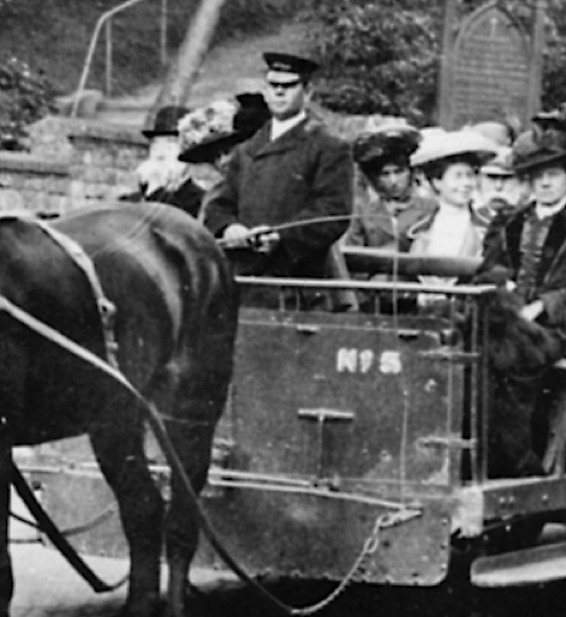
An enlargement of the above photograph showing the driver, James Pilcher, who is wearing a heavy-duty coachman's coat or greatcoat (with collar insignia); although his tensioned-crown peaked cap appears to bear a long badge, this is unclear, as it may simply be a reflection off the chin strap, which was, somewhat counter-intuitively, worn above the peak.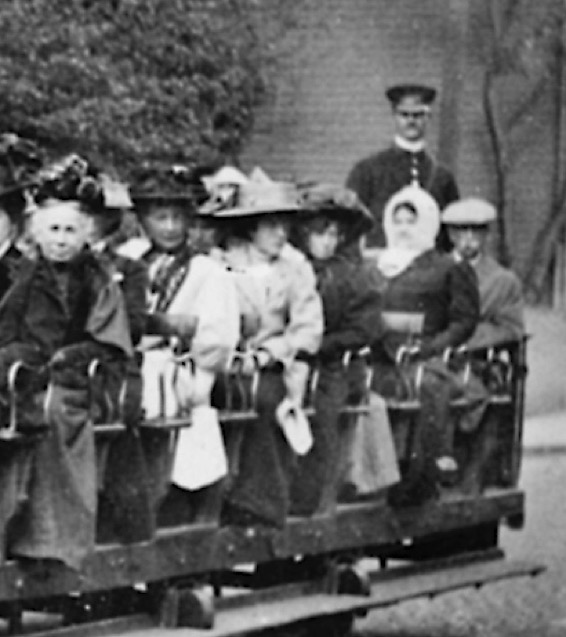
Another shot taken from the same photograph, this time showing the conductor, who is wearing the standard single-breasted conductor's coat with stand-up collars.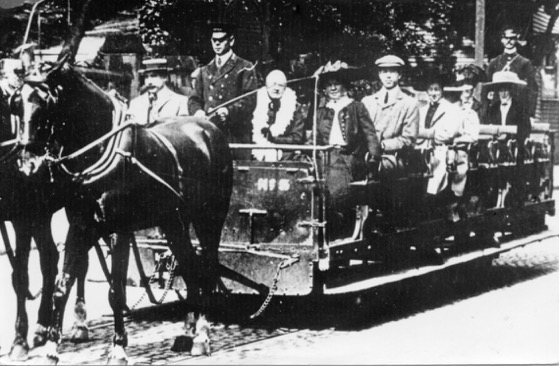
Another shot of toastrack-tram No 5, taken near the terminus in Sandgate — date unknown, but probably taken shortly before the Great War. Photo courtesy of the Tramways and Light Railway Society, with thanks to David Voice.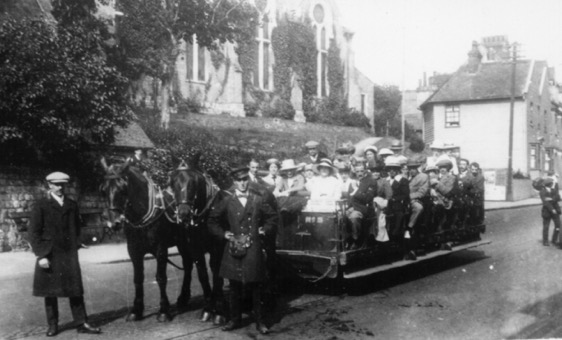
A rather proprietorial conductor stands with Tram No 5, once again near the terminus in Sandgate High Street — photo purportedly taken in 1913. Photo courtesy of the Tramways and Light Railway Society, with thanks to David Voice.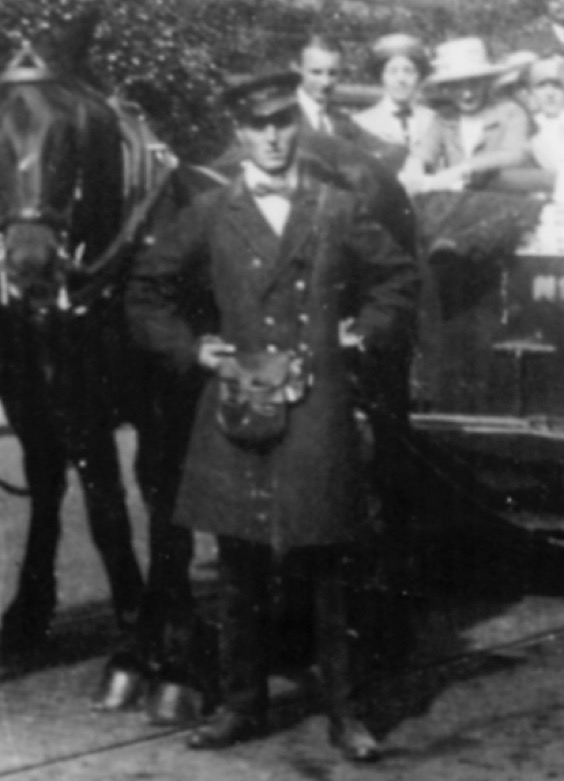
An enlargement of the above photograph showing the conductor, who is wearing a style of coat usually worn by drivers. By this time, these frock-style coats must have seemed somewhat anachronistic.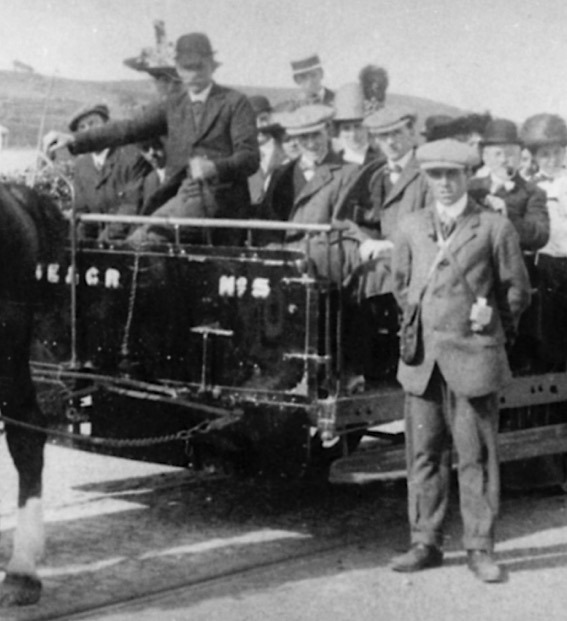
A driver and a conductor (Richard Jago), both in informal attire, pose for the camera outside the Imperial Hotel on Princes Parade — although this photograph is often stated to have been taken in 1921, a postally-used version suggests that it was taken in or shortly before 1913. Photo courtesy of the Tramways and Light Railway Society, with thanks to David Voice.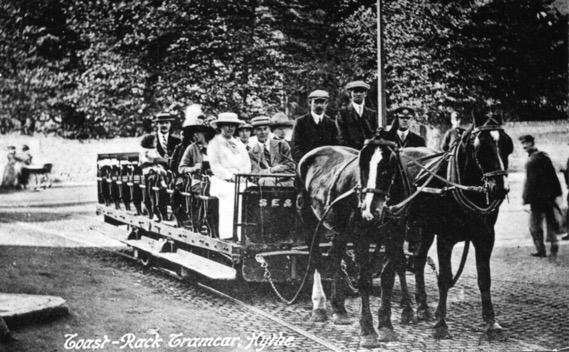
An unidentified horsecar (probably No 5), clearly marked 'SE&CR', standing outside the Red Lion terminus at Hythe — photo undated, though in view of the large baggy caps, probably taken shortly before or shortly after the Great War, when these were very fashionable. The individual in uniform is Conductor Harry Jago (brother of Richard Jago), whose cap appears to bear a large round cap badge. The only other photograph of an individual wearing a similar badge is of James Pilcher, who was the SECR foreman-in-charge; he effectively managed the company's trams and omnibuses, as well as its nearby town office. Photo courtesy of the Tramways and Light Railway Society, with thanks to David Voice.
Female staff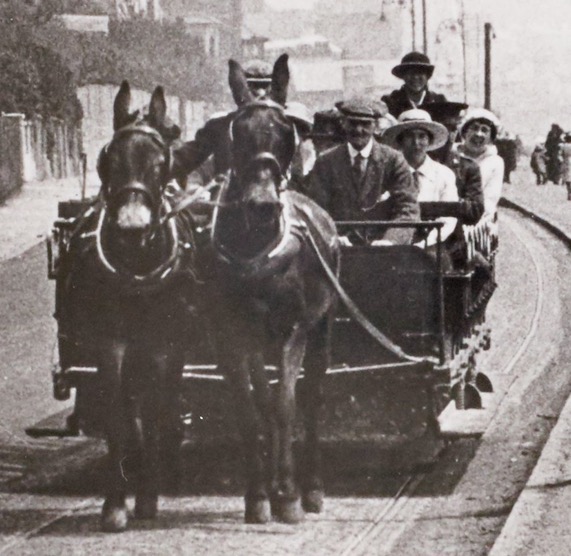
A rare photograph of a conductress, who can just be glimpsed on the rear of Toastrack Tram No 5. The tram is running westwards along Sandgate Esplanade, very probably in 1919, and is being hauled by two mules, horses being difficult to obtain directly after the conflict.